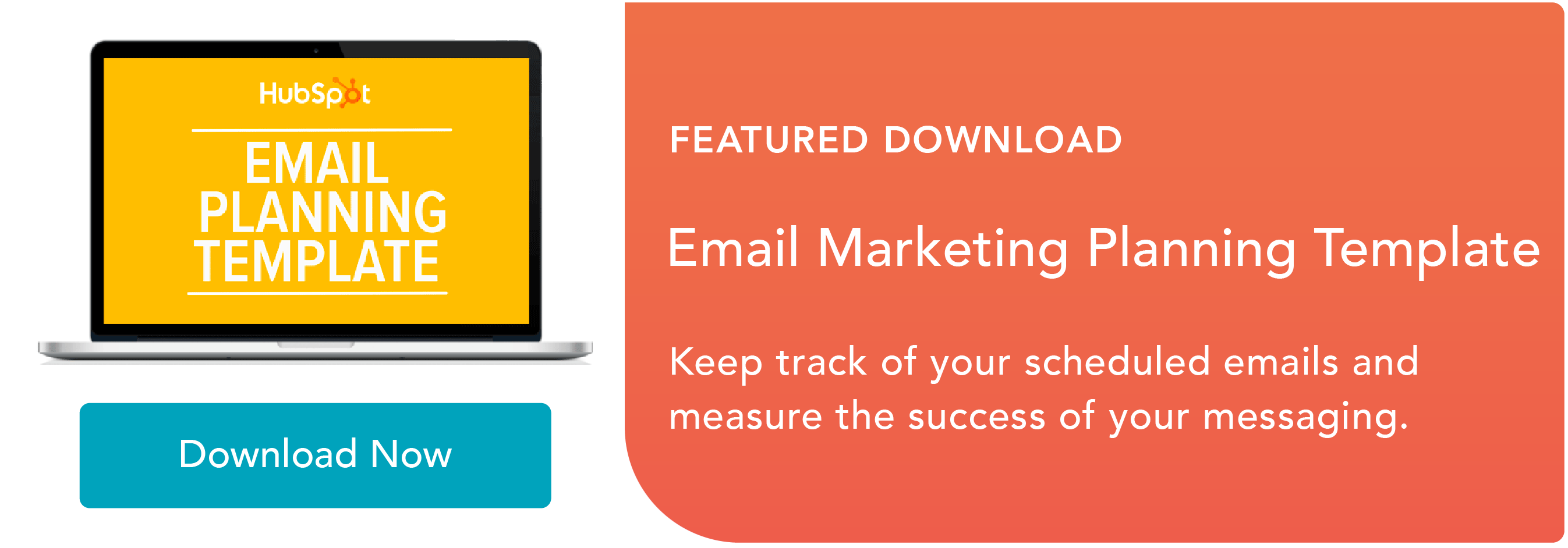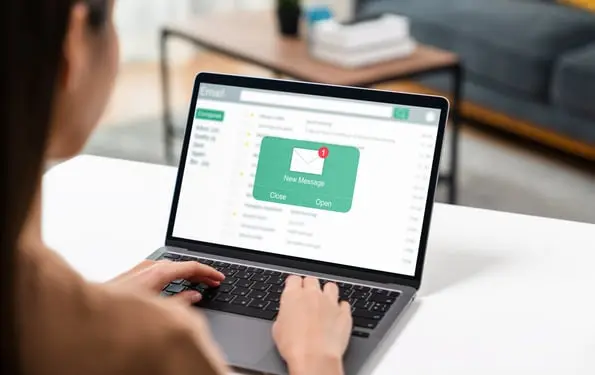1. Clickthrough Rate
Clickthrough rate (CTR) is likely the first answer you'll get when you ask an email marketer what metrics they track.
In fact, I surveyed 190 marketers and found that the majority (33%) rank clickthrough rate among the top two metrics they track when sending and reporting marketing emails.

Your clickthrough rate is the percentage of email recipients who clicked on one or more links in a given email.
The formula I and other marketers use to calculate this metric is dividing total or unique clicks by the number of delivered emails. I then multiply that answer by 100.
Here's how the formula looks:
(Total clicks OR unique clicks ÷ Number of delivered emails) * 100
For example, let's say I sent out 10,000 delivered emails that amassed a total of 500 clicks. I would divide the 500 total clicks by the 10,000 delivered emails and multiply the answer by 100, yielding a 5% clickthrough rate.
The math would look like this:
500 total clicks ÷ 10,000 delivered emails * 100 = 5% clickthrough rate
Pro Tip: Using total or unique clicks in the calculation above works, as long as you consistently use the same approach.
I like to call CTR the “day-to-day” email marketing metric because it lets you quickly calculate performance for every email you send. From there, you can track how your CTR changes over time.
CTR is also frequently used for determining the results of A/B tests, as these tests are often designed to find new ways to get more clicks in your emails.
How valuable is a clickthrough rate?
In my experience, CTR is a crucial metric for all email marketers to track, as it gives direct insight into how many people on an email list are engaging with the content and interested in learning more about a brand or offer.
Read this blog post to know what a “good” clickthrough rate is, according to industry benchmarks. HubSpot customers can click here to learn how to set up click tracking in your emails using HubSpot quickly.
2. Open Rate
This is the percentage of email recipients who open a given email.
31% of marketers in our survey listed open rate among the top two metrics they track when sending and reporting marketing emails, placing it right behind clickthrough rate.

Most email marketers are still bent over backward, trying to optimize their subject lines for higher open rates.
While this can have a positive impact — and more opens are a great thing — experience has taught me that marketers should be focused on optimizing their clickthrough rates instead.
The fact is that the open rate is a very misleading metric for a few reasons. Most importantly, an email is only counted as “opened” if the recipient also receives the images embedded in that message.
And many of your email users likely have image-blocking enabled on their email clients.
This means that even if they open the email, they won’t be included in your open rate, making it an inaccurate and unreliable metric for marketers, as it underreports your actual numbers.
It's also important to note that 22% of marketing professionals in our survey say Apple's latest Email Privacy Protection feature impacts the reporting accuracy of open rates.
Fortunately, some marketers are finding workaround by creating opportunities for users to voluntarily give information via gates content such as webinar signups and virtual events.
How valuable is your email open rate?
You can get some value out of the open rate as a metric if you use it as a comparative metric.
For instance, comparing the open rates of this week‘s email sent to last week’s (both to the same lists) might give you some insight since the variables are somewhat controlled.
3. Conversion Rate
After an email recipient has clicked through on your email, the next goal is typically to get them to convert on your offer, in other words, to take the action your email has asked them to take.
So, if you‘re sending an email to offer your audience the chance to download a free ebook, you’d consider anyone who actually downloads that ebook to be a conversion.
Conversion rate is the percentage of email recipients who click on a link within an email and completes a desired action, such as filling out a lead generation form or purchasing a product.
To calculate the conversion rate, I divide the number of people who completed the desired action by the number of emails delivered and multiply the answer by 100. The formula looks like this:
(Number of people who completed the desired action ÷ Number of total emails delivered) * 100
Let‘s say I have 10,0000 total emails delivered, and 400 of the emails’ recipients completed the desired action. To get the conversion rate, I'd divide 400 by 10,000, which equals 0.04. Multiple that by 100, and the conversion rate is 4%.
I've found that conversion rate is one of the most important metrics for determining how my emails achieve my goals.
This is because the definition of a conversion is directly tied to the call-to-action in an email, and my call-to-action should be directly connected to the overall goal of my email marketing.
Pro Tip: To measure the conversion rate of your emails, you'll need to integrate your email platform and web analytics.
You can do this by creating unique tracking URLs for your email links that identify the source of the click as coming from a specific email campaign.
How valuable is your conversion rate?
If your goal is to generate leads, conversion rates are significant as they show you how successful your newsletters are at actually generating prospects and leads.
Targeting the right email recipients by segmenting your list based on demographics, past interactions, and preferences is crucial for boosting conversion rates. This approach ensures your message resonates with the audience, leading to higher engagement and a more successful email marketing strategy.
4. Bounce Rate
There are two variations of this metric to track: “hard” and “soft.” Before we get into that, however, let's discuss what a bounce rate is.
Bounce rate is the percentage of total emails sent that could not be successfully delivered to the recipient's inbox. To calculate it, divide the number of bounced emails by the number of emails sent, and multiply by the answer by 100:
(Number of bounced emails ÷ Total number of emails sent) * 100
Example: 75 bounced emails ÷ 10,000 total emails sent * 100 = 0.75% bounce rate
There are two kinds of bounces to track: “hard” and “soft.”
I've found soft bounces result from a temporary problem with a valid email address, such as a full inbox or a problem with the recipient’s server.
The recipient’s server may hold these emails for delivery once the problem clears up, or you may try re-sending your email message to soft bounces.
Hard bounces result from an invalid, closed, or non-existent email address, and these emails will never be successfully delivered.
You should immediately remove complex bounce addresses from your email list because internet service providers (ISPs) use bounce rates to determine an email sender’s reputation.
How valuable is a bounce rate?
While a bounce rate doesn‘t directly link to your goals, you should still look at it to make sure there are no deep issues with your emails. I’ve learned the hard way that having too many hard bounces can make your company look like a spammer in the eyes of an ISP.
Read this blog post to learn more about hard and soft bounces.
5. List Growth Rate
Aside from the call-to-action metrics (CTR, conversion rates), I also suggest keeping tabs on list growth and loss. Of course, you should aim to grow your list to extend your reach, expand your audience, and position yourself as an industry thought leader.
Your list growth rate is the rate at which your email list grows. Here's the formula to calculate it:
([(Number of new subscribers) minus (Number of unsubscribes + email/spam complaints)] ÷ Total number of email addresses on your list]) * 100
Example: (500 new subscribers - 100 unsubscribes and email/spam complaints) ÷ 10,000 email addresses on the list * 100 = 4% list growth rate
How valuable is your list growth rate?
Believe it or not, there's a natural decay of your email marketing list, and it expires by about 22.71% every year — which means that it's more important than ever to pay attention to growing your subscriber list and keeping it at a healthy size.
6. Email Sharing/Forwarding Rate
I used to think the rate at which my email recipients forward or share my emails with others was insignificant, but I‘ve since learned it’s arguably one of the most important metrics marketers should track.
Why? Because this is how you generate new contacts. The folks on your email list are already in your database. So, while conversion is still a primary focus, this doesn't help you attract new leads.
The percentage of email recipients who clicked on a “share this” button to post email content to a social network and/or clicked on a “forward to a friend” button.
This formula for your email sharing/forwarding rate is:
(Number of clicks on a share and/or forward button ÷ Number of total delivered emails) * 100
For example: 100 clicks on a share/forward button ÷ 10,000 total delivered emails * 100 = 1% email sharing/forwarding rate
Encourage your readers to pass along your email to a friend or colleague if they found the content helpful, and start tracking how many new people you can add to your database this way. Read this blog post for tips on getting people to forward your emails.
Why Email Sharing and Forwarding Rates Are Valuable
Keep a careful eye on your sharing rates to discover which types of articles and offers tend to get shared the most, and use that insight when you plan email campaigns in the future.
7. Overall ROI
This metric is the overall return on investment for your email campaigns. In other words, total revenue is divided by real spend.
Below is the most basic formula to calculate ROI — but there are several ways to calculate the ROI of your email campaigns:
[($ in additional sales made minus $ invested in the campaign) ÷ $ invested in the campaign] * 100
Example: ($1,000 in additional sales - $100 invested in the campaign / $100 supported in the campaign) * 100 = a 900% return on investment for the campaign
Depending on your type of business, you might prefer a different one.
Pro Tip: As with every marketing channel, you should be able to determine the overall ROI of your email marketing. If you still need to, set up an SLA system whereby you assign different values to various types of leads based on their likelihood to generate revenue for your company.
How valuable is ROI?
How many of these types of leads did you generate via email marketing? How does this translate to potential revenue? Actual revenue?
These metrics will help you show your boss and sales team how valuable email marketing is as a channel that drives accurate, tangible results.
8. Unsubscribe Rate
The unsubscribe rate is the percentage of email recipients unsubscribe from your send list after opening a given email.
As with the open rate, the unsubscribe rate isn’t a reliable picture of the health of your email list. Many subscribers tired of receiving your brand's email messages won’t bother to go through the formal unsubscribe process.
They’ll stop opening, reading, and clicking on your email messages.
That‘s why I’ve found measuring subscriber engagement by clickthrough and conversion rates is much more effective. From there, you can keep an eye out for unengaged subscribers so you can consider removing them at some point, as we went over earlier.
How valuable is an unsubscribe rate?
Although your unsubscribe rate doesn't directly relate to your goals, checking it monthly helps calculate your overall list growth rate. So, do keep an eye on it every once in a while.
How to Know Which Email Metrics to Track, Based on Your Goals
The objective of your email marketing strategy may vary from that of similar companies, and it can even change within your own organization over time. There are various email marketing benchmarks that you may strive to achieve.
But again, you must determine precisely what you're looking to achieve with your email marketing before you begin (or continue) to send and measure your emails.
Here's how you can align your specific goal with critical metrics.
Subscriber List Growth Rate
If you focus on growing the top of your funnel -- attracting more visitors to your site, signing up more blog subscribers, and getting more people to use your free tools, your goal is to grow your subscriber list.
Your emails will likely contain calls to action such as “Subscribe to Our Blog” or “Join Our Weekly Email List.” Of course, the most important metric you should be tracking for this goal is the growth rate of your subscriber list.
Unengaged Subscribers
Just as you want to track and grow your subscribers, it's also essential to keep an eye on your unengaged subscribers — and consider removing them from your list altogether. Why?
Because sending emails to people who aren't engaged with your emails (called “graymail”) can hurt the deliverability of your email overall.
Email clients might get tipped off by low engagement rates and deliver emails from known graymail senders straight to recipients' “junk” folders, meaning your emails will technically get sent and delivered but won't necessarily be seen.
Here at HubSpot, we deliberately unsubscribed 250,000 people from HubSpot's Marketing Blog, including those who had opted in to receive emails about new content we published on the blog.
This subscriber purge brought our total subscriber count from 550,000 down to 300,000. Read this blog post to learn why and how we purged our subscriber list and why you might consider doing the same.
Number of New (or Total) Leads Generated
Instead of focusing on subscribers, you'd like to work on growing lead generation.
If this is the case, you should be sending emails that offer lead generation content — in other words, content that requires the viewer to fill out a lead capture form to access it.
If the goal of your email marketing is lead gen, you should be tracking how many leads you capture every day and every month. Depending on your priorities, you can focus on all leads generated or only new ones added to your database.
Lead-to-Customer Conversion Rate
Finally, let's say you want to focus more on the middle/bottom of your marketing funnel and convert your existing leads into customers.
If this is your goal, your emails will likely provide content more closely related to your business and your product or service.
Your calls-to-action may include “Get a demo,” “Watch a Video of Our Product in Action,” or “Start a Free Trial.” If this is your goal, you should track your lead-to-customer conversion rate changes.
As obvious as this all seems, you‘d be surprised how many email marketers determine their goals and then don’t bother to track their progress against them.
Ensure you can follow how closely you‘re trending toward your goal at any point during the month and that you’re looking carefully at any changes in these metrics month over month.
And if you need assistance tracking the performance of your marketing emails, HubSpot‘s Email Marketing Tools are available to help you create, personalize, and optimize your email campaigns.
Even better, the tools also include email analytics to observe your emails’ effectiveness.
To help you with your email marketing goals, you can also leverage HubSpot's AI tools like our Email Writer that can help you generate copy that suits your needs.
Navigating Email Marketing Metrics
The bottom line? Be smart about which metrics you're tracking, and ensure you can effectively measure your individual email performance, the health of your email list, and your progress toward your overarching goals.
As long as you can determine each of those, you're on the right track for more effective email marketing.
Editor's Note: This post was originally published in March 2014 and has been updated for accuracy and comprehensiveness.

.jpg)





![How to Embed Video in Email [Quick Tip]](https://53.fs1.hubspotusercontent-na1.net/hubfs/53/embed-video-in-email.jpg)
![23 Email Marketing Tips to Improve Open & Clickthrough Rates [+HubSpot Blog Data]](https://53.fs1.hubspotusercontent-na1.net/hubfs/53/make-emails-more-clickable_8.webp)

![What is Comparative Advertising? [+ Examples]](https://53.fs1.hubspotusercontent-na1.net/hubfs/53/Untitled%20design-Aug-17-2022-02-39-51-39-PM.png)
![How to Prepare an Advertising Plan [Free Template]](https://53.fs1.hubspotusercontent-na1.net/hubfs/53/advertising%20plan%20example.jpg)
![Email Marketing Benchmarks [HubSpot Data]](https://53.fs1.hubspotusercontent-na1.net/hubfs/53/email%20marketing%20featured%20image.webp)
